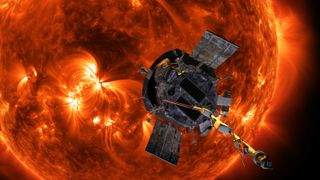NASA's sun-grazing Parker Solar Probe will zip through its 12th stellar closeup today
It will fly about 5 million miles from the sun's surface.

NASA's sun-grazing spacecraft will make its 12th close flyby of our star on Wednesday (June 1), marking the halfway point of the mission.
During this flyby, the Parker Solar Probe, which is specially designed to take the extreme solar heat and radiation, will get as close as 5.3 million miles (8.5 million kilometers) of the solar surface, which is about as near as it drew during the last close approach on Feb. 25.
Flying 14 times closer than the orbit of Mercury — our solar system's closest planet to the sun — Parker will reach a top speed of 364,660 mph (586,860 kph). That's roughly 21 times faster than the International Space Station's speed as it orbits Earth. The exact time of the closest approach, known as perihelion, will be 6:50 p.m. EDT (2250 GMT), according to a spokesperson at the Johns Hopkins University Applied Physics Laboratory (JHUAPL), which oversees the mission.
Related: What's inside the sun? A star tour from the inside out
Parker isn't set to break its speed record again this time, as it has several times throughout its mission. But what's more valuable that superlatives is how so many close passes are providing information about the sun's complex behavior, which leads to phenomena such as superheating the million-degree corona that is much hotter than the plasma on the sun's surface.
"The Parker Solar Probe mission is not only reshaping the landscape of solar and heliophysics research before our eyes, but it is enticing us to pursue challenging ideas that, just a few years ago, we considered out of reach," Nour Raouafi, the mission's project scientist from JHUAPL, said in a recent statement.
The mission has crossed the Alfvén critical surface now numerous times, for example. That's where solar material leaves the surface and becomes the solar wind, a critical radiation vector that affects space weather all over the solar system. Scientists now know that the boundary is wrinkled, rather than a smooth curve.
Get the Space.com Newsletter
Breaking space news, the latest updates on rocket launches, skywatching events and more!
"Sampling the solar wind below the Alfvén critical boundary is essential to understanding the heating and acceleration of the solar wind," stated BWX Technologies' Justin Kasper, principal investigator for Parker's Solar Wind Electrons Alphas and Protons (SWEAP) instrument.
Some of Parker's other discoveries include finding a dust-free area around the sun where the grains sublimate due to extreme heat, determining the origin of magnetic field "switchbacks" (or field flips) at magnetic "funnels" in the solar surface, and better understanding the nature of solar energetic particles.
The mission is expected to better uncover the nature of space weather, which can affect our planet by shorting out satellites, power lines or other infrastructure during the most powerful storms. More usually, however, the events are harmless and produce colorful displays high in up in our atmosphere called auroras.
Parker Solar Probe launched in August 2018 and includes four different instrument suites. It also does periodic planetary flybys of Venus to pick up speed or adjust course, sometimes nabbing stunning images along the way. The next such flyby will occur in August 2023.
All told, the Parker Solar Probe is expected to make 24 close passes of the sun during its seven-year mission, which is scheduled to wrap up in mid-2025.
Follow Elizabeth Howell on Twitter @howellspace. Follow us on Twitter @Spacedotcom and on Facebook.
Join our Space Forums to keep talking space on the latest missions, night sky and more! And if you have a news tip, correction or comment, let us know at: community@space.com.

Elizabeth Howell (she/her), Ph.D., is a staff writer in the spaceflight channel since 2022 covering diversity, education and gaming as well. She was contributing writer for Space.com for 10 years before joining full-time. Elizabeth's reporting includes multiple exclusives with the White House and Office of the Vice-President of the United States, an exclusive conversation with aspiring space tourist (and NSYNC bassist) Lance Bass, speaking several times with the International Space Station, witnessing five human spaceflight launches on two continents, flying parabolic, working inside a spacesuit, and participating in a simulated Mars mission. Her latest book, "Why Am I Taller?", is co-written with astronaut Dave Williams. Elizabeth holds a Ph.D. and M.Sc. in Space Studies from the University of North Dakota, a Bachelor of Journalism from Canada's Carleton University and a Bachelor of History from Canada's Athabasca University. Elizabeth is also a post-secondary instructor in communications and science at several institutions since 2015; her experience includes developing and teaching an astronomy course at Canada's Algonquin College (with Indigenous content as well) to more than 1,000 students since 2020. Elizabeth first got interested in space after watching the movie Apollo 13 in 1996, and still wants to be an astronaut someday. Mastodon: https://qoto.org/@howellspace
Most Popular


